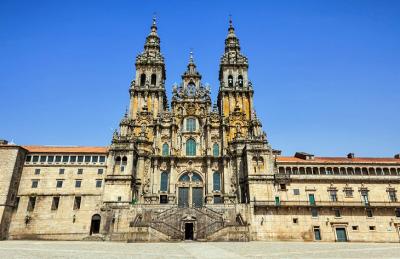The magnificent cathedral of Santiago (St. James) was built to house and honor the relics of the saint, and it has been the goal of pilgrims since the Middle Ages, the culmination of their completing the famed Camino de Santiago.
Description
One of the outstanding monuments of Early Romanesque architecture, the cathedral was built between 1060 and 1211, and despite the Baroque transformation of the exterior in the 16th to 18th centuries, the interior is still in the purest Early Romanesque style.
You'll see both of these periods at play as you enter the west front, through one of Spain's most impressive church facades. Step inside to face the Pórtico de la Gloria, part of the old west front now concealed by the 18th-century facade. This triple doorway is one of the largest and most magnificent collections of Romanesque sculpture in the world.
The focal point of the interior is the elaborately decorated Capilla Mayor, built over the Apostle's tomb. In the center of the high altar of jasper, alabaster, and silver is a 13th-century wooden figure of the Apostle, richly adorned in precious metals and gems.
On either side, narrow staircases lead up behind the figure so that pilgrims can kiss the Apostle's cloak - culminating their pilgrimage. In a crypt under the altar, the Apostle's remains are in a silver casket.

